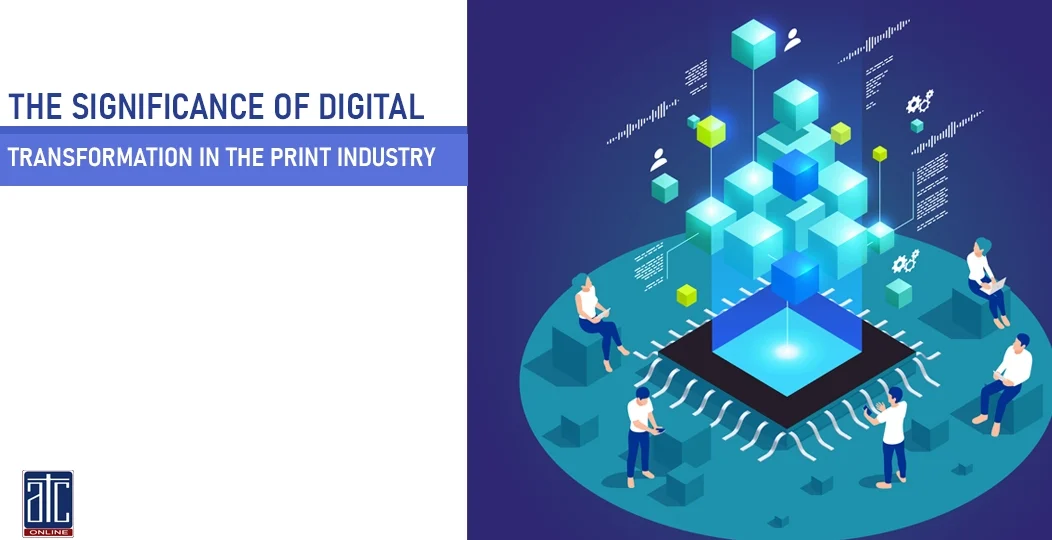
The adoption and integration of digital technology and processes inside the traditional print industry is referred to as the print industry’s digital transformation. Digital transformation has had a huge impact on several industries, including the printing industry. The introduction of digital technology has transformed the way printing enterprises work, allowing them to adapt to shifting market demands and capitalize on new opportunities. Here are some of the most important implications of digital transformation in the printing industry:
DIGITAL PRINTING TECHNOLOGY

Digital printing has emerged as an industrial game changer. It entails the use of digital files that are immediately sent to the printing press, hence eliminating the need for traditional printing plates. Digital printing enables quicker setup times, shorter print runs, changeable data printing, and on-demand printing. This technology enables printing companies to produce personalized and customized print products in response to changing customer requests.
WORK FLOW AUTOMATION

The automation of many operations within print manufacturing workflows has been aided by digital transformation. Prepress processes are automated using computer-to-plate (CTP) systems, which reduces manual involvement and mistakes. Workflow management software allows for the smooth coordination of processes, such as file submission and pre-flighting, as well as color management, printing, and finishing. Automation increases efficiency, lowers costs, and shortens turnaround times.
WEB-TO-PRINT & PRINT ON-DEMAND SOLUTIONS

Web-to-print platforms enable customers to submit print orders online, streamlining the ordering process. Customers can upload files, choose print specifications, customize designs, and even track order progress. Web-to-print solutions provide convenience, enhance customer experience, and enable printing companies to efficiently manage and process a large volume of orders.
Digital transformation has popularized the concept of print-on-demand (POD). Instead of large print runs, printing companies can produce smaller quantities of printed materials as per specific customer requirements. POD reduces the need for inventory storage, minimizes waste, and allows for quick and cost-effective printing of materials when needed. It is particularly useful for time-sensitive or niche projects.
AUGMENTED REALITY & INTERACTIVE PRINTING

The combination of print materials and augmented reality (AR) technologies has created new opportunities for immersive and interactive experiences. Mobile devices may scan AR-enabled print items to launch digital content like films, 3D models, or animations. Print products become more engaging and useful as a result of the confluence of print and digital, which improves interaction, narrative, and engagement.
INCREASED EFFICIENCY & COST-SAVINGS

Digital transformation has streamlined and automated many aspects of the printing process, leading to improved efficiency. Digital printing technology allows for faster setup times, reduced waste, and quicker turnaround times, enabling printing companies to handle a larger volume of orders with fewer resources. Automated workflows and digital file management systems further enhance productivity by eliminating manual tasks and reducing errors.
Traditional printing methods often involve significant setup costs, especially for smaller print runs. Digital printing eliminates the need for expensive plates, films, and setup time, making it more cost-effective for shorter print runs or personalized printing. Moreover, digital technologies enable print-on-demand capabilities, minimizing inventory costs and reducing the risk of overproduction.
SHORTER TIME TO MARKET

Digital transformation in printing enables quicker turnaround times, enabling businesses to respond to market demands more rapidly. With digital technology, print jobs can be produced and delivered in a fraction of the time compared to traditional methods. This agility is particularly beneficial for time-sensitive projects, last-minute changes, or when speed-to-market is critical.
DATA ANALYTICS & PERSONALIZATION

The digital transformation has enabled the collection and analysis of customer data to gain insights into preferences, behavior, and trends. Printing companies can leverage this data to offer personalized and targeted print solutions, improving customer engagement and response rates. Data analytics also helps in strategic decision-making, marketing campaigns, and resource allocation.
One of the major advantages of digital printing is its ability to produce highly personalized and customized print products. Variable data printing allows for the integration of personalized text, images, or other content into each printed piece, enabling targeted marketing campaigns and individualized communications. This level of customization can lead to higher customer engagement and response rates.
SUSTAINABILITY

Digital printing can contribute to sustainability efforts within the printing industry. Digital printing technologies generally consume fewer resources, produce less waste, and emit fewer harmful chemicals compared to traditional methods. Print-on-demand capabilities help reduce paper waste and unnecessary production. Additionally, digital processes enable the use of environmentally friendly inks and materials.
INTEGRATION WITH E-COMMERCE PLATFORMS

The rise of e-commerce and online platforms has influenced the printing industry significantly. Websites and e-commerce platforms allow businesses to showcase their services, provide product information, and engage with customers. Online integration enables seamless order processing, payment collection. Digital transformation enables printing businesses to integrate with online marketplaces, e-commerce websites, and web-to-print portals. This integration facilitates seamless order processing, automated file uploading, and online proofing, enhancing customer convenience and overall experience.
DIVERSIFICATION OF SERVICES

Digital transformation has opened up new avenues for revenue generation and expanded the range of services that printing companies can offer. Alongside traditional print materials, digital printing allows for the production of various promotional items, packaging materials, labels, and signage. This diversification helps printing businesses stay competitive and cater to a broader range of customer needs.
FINAL THOUGHTS
In conclusion, the printing sector has benefited greatly from the digital transformation, including greater productivity, cost savings, options for customization, shortened time to market, diversification of services, integration with online platforms, and better sustainability. Printing companies may position themselves for success in a changing market environment by embracing digital technology.
ATC ONLINE’s PACIFYCA is a complete automation software solution for modern printing firms. Our ERP is a simple yet effective one-point integrated platform that synchronizes all important organizational entities in your firm. For more on PACIFYCA ERP for Printing Sector, please visit us at: www.atconline.biz
You could also contact us at https://atconline.biz/contact/ for business enquires and product information.
















